One of Amtrak's most scenic trains, the Coast Starlight, also provides the most variety of any in the railroad's fleet. On the route between Seattle and Los Angeles, the daily trains provide views of ocean beaches, mountain passes, high desert—and that's not all.
Nightfall happens on different segments of the route depending upon your direction of travel.
Which direction offers the best scenery? There are significant differences. Ride along with us and we'll describe what you will see out the window.
As we're waiting to board Amtrak's Coast Starlight #11 southbound from Klamath Falls, Oregon, the November night is cloudy and the temperature below freezing. It's a good time to be heading south. As travelers who don't fly, we frequently make trips on the Coast Starlight.
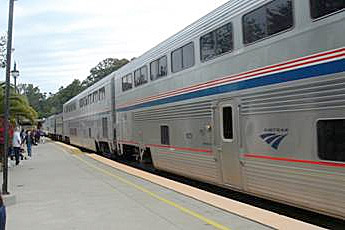
Amtrak #11 southbound departed Seattle this morning and rolled past Mt.Rainier and along Puget Sound. Passengers got a glimpse of the snow-capped Olympic Peninsula, and then crossed over the wide Columbia and Willamette Rivers. Arriving in Portland with its many bridges and colorful glass-covered high-rises, #11 stopped at the vintage station. Flowering gardens in front flourish under the tower with its "Go by Train" sign. Next, the rails skirted the Willamette River and the wine-producing Willamette Valley. After leaving Eugene, Oregon, the sun slipped behind the mountains. This train will remain in the dark until tomorrow morning when the sunrise highlights it Sacramento.
Here's what the passengers on our southbound train miss after nightfall -- but what northbound Coast Starlight travelers do get to see during daylight:
* Odell Lake, surrounded by high forested peaks
* The Cascade Summit wilderness.
* A rain forest, complete with ferns and waterfalls,
* Sagebrush and juniper on the high desert.
* Root Beer Falls splashing through a rocky gorge.
* Upper Klamath Lake with its reflection of Mt. McLaughlin
Now we climb aboard to find our cozy bedroom with its fresh white sheets, plump pillows, and extra blankets aglow with subdued reading lights.
The moon is shining dimly through broken clouds. While we won't see Mt. Shasta tonight, passengers on the northbound Coast Starlight #14 will wake up tomorrow to see sunrise over the huge dormant volcano.
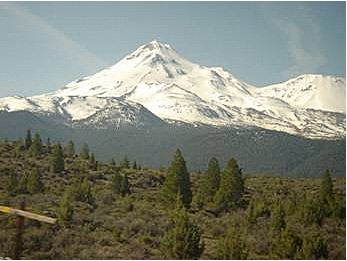
Tonight, the soothing sound of the whistle and the music of the rails lulls us to sleep.
We awake as the sun guilds Sacramento's twenty-first century high-rises. Then #11 pauses at the Spanish-style station at Davis, surrounded by palm trees.
As the train moves along, evidence of California's growing pains appear. The freeway is jammed with morning commuters. There are warehouses—festooned with graffiti applied on top of other graffiti—then construction equipment, and yards full of dead automobiles. Enormous dirt fills dumped into the bay have relocated the shoreline of Suisun Bay far from the tracks where gently lapping waves and morning fisherman could once be seen right out the window. This stretch of track is, thankfully, hidden by darkness on the northbound train.
San Francisco's unmistakable symbol, the Golden Gate Bridge, shimmers in the morning sun far to the west. (Train #14 will be in darkness here and miss a view of the famous bridge.)
After a pause at Oakland's Jack London Square station, we southbound passengers go past the back yards of endless subdivisions.
South of San Jose, broken sunbeams play on the coastal mountains to the west. The Salinas Valley has huge fields filled with eternally fertile soil, plowed into perfect geometric patterns. Lines of planted trees serve as windbreaks.
Artichokes, strawberries, tomatoes, cabbage, Brussels sprouts and corn are just some of the foodstuffs that flourish here, although many fields now lie fallow for the winter.
This broad valley was formed by the Salinas River, now mostly hidden by wide swaths of sand and shaded by trees.
The tracks have few curves here parallel to Hwy 101. The train accelerates to 79 mph, passing cars and 18-wheelers. A red setter leans out the open window of one truck, ears and tongue flapping in the breeze, as it surveys the train.
Orchards and vineyards come into view. The little valley towns, with names like Soledad and San Miguel, often have a saloon on the main street. Look for the ubiquitous red neon martini glass, staggering atop its drunken stem, above the door.
Arid hills to the east are just beginning to show a trace of green. Once the rainy season gets underway, these hills will turn a brilliant green that hits you in the back of the eyeball. By April the green has usually faded and dried.
There's a stop in Paso Robles, renowned for its fine wineries, neat horse ranches and oak trees.
Number 11 now works its way uphill towards the Santa Lucia Mountains and over the indescribably wild scenic wilderness of the Cuesta Grade.
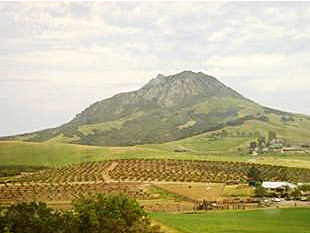
Surrounded by palms, eucalyptus, and pepper trees, San Luis Obispo station offers a mountain vista in every direction.
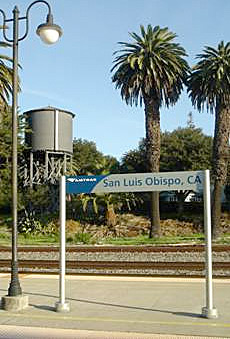
A few miles further along, the tracks meet the ocean. Views of the white-capped water, with many deserted beaches along the way, are enticing as we traverse the edge of Vandenberg Missile Base. Past the lighthouse at Point Conception, the coastline turns eastward.
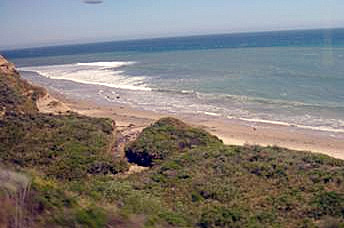
The Channel Islands come into view, while dry arroyos appear on the inland side of the tracks. See that cove? It looks like it belongs in the South Pacific as waving palm trees overlook Refugio Beach State Park.
A stop at Santa Barbara's train station positions our Superliner next to a huge ancient fig tree, its gnarled roots showing above the lawn. By the time we roll out of Oxnard, dusk is arriving.
The tracks eventually lead through the outskirts of Los Angeles. The cement-lined course of the Los Angeles River is next to the tracks here. Let's get ready to detrain. Number 11 is pulling into the lavish art-deco station with its Spanish tile, arches, and tropical gardens.
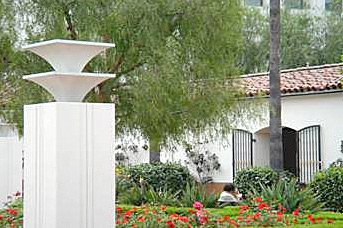
Here at the end of the line—Los Angeles—the Coast Starlight will stay overnight. Tomorrow morning, cleaned and re-stocked, it will become #14 and begin its more scenic journey towards Seattle.
It will spend most of the day next to the ocean, and nightfall will descend by Oakland, California. It will travel through the blighted industrial wreckage in the dark. Before it reaches the Oregon border south of Klamath Falls, the sun will have been up awhile.
And here's where the big difference begins. Northbound passengers wake up in a different world, at an altitude of over 3,500 feet. This is far Northern California, with startling wild-west scenery—open spaces of lava-rock high desert, sagebrush and pines. Only Coast Starlight passengers on #14 see the sunrise over Mt. Shasta's snow and glacier-covered northwest face along with their morning coffee. This dormant volcano, with its mystical ambiance, towers over the rails at 14,162 feet as the train snakes its way over the mountain's gigantic shoulder.
By the time #14 rolls into Klamath Falls, the ponderosas have given way to junipers. After that the tracks run along the edge of Upper Klamath Lake, where bald eagles and white pelicans compete for attention as more Cascade volcanoes come into view. Mt. Shasta distinctive double-peaked shape, now over 100 miles behind, is still visible through the clear mountain air.
Away from the highway now, the train begins to climb towards Cascade Summit and into a rain forest where ferns and dogwoods grow and waterfalls cascade. After Eugene, this train will enter the Willamette Valley scenery that southbound passengers also see. The sun will set about the time #14 reaches Puget Sound, but lights twinkling on the islands to the west will be visible. Then Coast Starlight #14 will arrive at Seattle, its northern terminus, and be readied for the next day's southbound odyssey.
Do you agree that the northbound route is the most scenic?
Regards, Sylvia Blishak, Train Travel Consulting at Accent on Travel. sylvia@traintravelconsulting.com
NAMED ONE OF THE WORLD'S TOP TRAVEL SPECIALISTS BY CONDE NAST TRAVELER MAGAZINE SINCE 2002. 3939 S. Sixth St. #331, Klamath Falls, OR 97603 Phone: 800 347 0645 Fax: 541 883 6457 http://www.traintravelconsulting.com
|